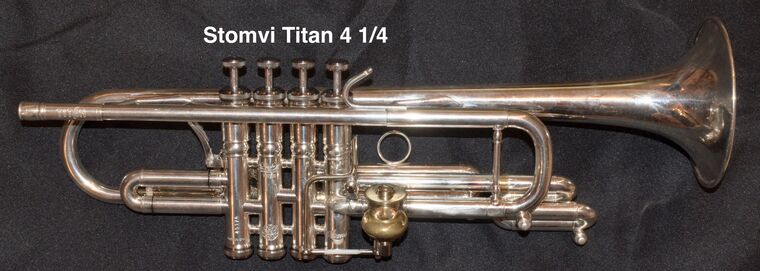To 4-valve, or not to 4-valve - That is the dilemma
-
I didn't find an older post regarding 4-valve trumpets, so figured it was ok to start a new one. Please forgive me if I missed it.
I've been researching 4-valve trumpets for some time now and have come to the conclusion that for the most part, it seems like most manufacturers just add one more valve to the trumpet as more of an afterthought than really giving it a thorough and comprehensive technical study it deserves to cater to those wanting the extra valve just to increase their lower range.
I've been looking closely at Stomvi's line of Titan 4-valve instruments and it appears that they have given a lot of thought to it's architecture compared to the competition. I'm wondering has anyone has had the opportunity to play 4-valve Stomvi trumpets (or other 4-valve trumpets in general) and what their thoughts are. Do you see advantages just beyond extending the lower range? Is is a struggle to keep in tune in the various registers? etc.
-
I play two 4-Valve Flugelhorns, a Getzen and a Kanstul. For the flugelhorn, the 4th valve provides better intonation for 1,3 and 1,2,3 valve configurations all such combinations starting from the first D below staff. It also eases the bridge between lower register and pedal tone and does get me to harmonics that I could not reach easily on a 3 valve flugelhorn. My experience is unique however to a flugelhorn, not a trumpet.
I have never played a 4 valve trumpet and not sure the upper range argument would be reasoning for me to have such a horn after watching the Stomvi's 4 valve video. The double high C played by the 4 valve trumpet on the last note is performed with no valves used (standard key use). So I am not sure why they would make such a claim. I have not trouble incorporating the double high C on my Harrelson, Martin Committee and Olds Ambassador trumpets, all with 3 valves.
Again, I love the 4 valve feature on the flugelhorn for intonation and lower note bridging features. Also hate the idea of playing the fourth valve with the index finger of the left hand. Many people use 4 valve horns this way. I like keeping the right hand in charge of all the valve work so have no pinky finger ring on the 4 valve Getzen (which is the standard issue for that horn) and had Kanstul not install the pinky ring ring on their flugelhorn (which was their standard feature).
-
4 valved trumpets are NOT an afterthought. The 4th valve is generally a purpose built device. It can be permanently attached to the valve block or integrated into the tuning slide.
We have 4th valves for playing ¼ tones - found in middle east and experimental music.
There are ½ tone valves for easily switching a Bb trumpet to A. These are found mostly on vintage instruments built between 1900 and 1920.
There are also whole tone 4th valves to extend the range of a modern orchestral C trumpet to low E which allows playing the handful of very low Bb parts.
Then there are 4th valves that lower the pitch by a 4th to extend the chromatic range to pedal C. These can often be found on high pitched trumpets like in high G, high A and high Bb. In this case, they extend the range to allow playing the lowest notes for typical baroque music.
One further use of a 4th valve is to allow switching between 2 bells (Bobby Shew Shew horn).
My thoughts are if you are not playing specialty music, the 4th valve is useless and can actually make the instrument harder to play.
-
@ROWUK Most of my playing is on 4 valve trumpets. I use a quarter tone Bb for most of my jazz gigs, an ascending valve Bb for Concert Band and an ascending valve C for classical. I also have a double bell Bb which I almost never use (anyone want one?) and i have a prototype 4 valve (low F) Bb. When I need the extended low E on my C I have a third slide equipped with an 4th valve extension, rather like the Yamaha piccolo. BTW they all play great!
-
@Trumpetsplus BTW to the OP, I once added a 5th valve to a brand new Stomvi Titan. It was one of my last jobs before leaving the US for Germany.

-
@Trumpetsplus I remember you bringing the ascending C when you visited. Wonderful horn!
-
@ROWUK I am closer now....